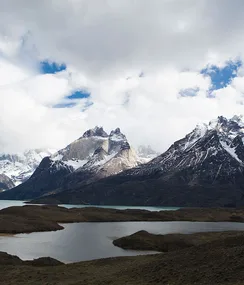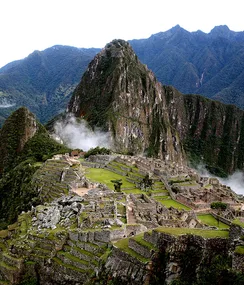On a drizzly July morning in 1911, a handful of indigenous Andean farmers and Hiram Bingham III, an American scholar and explorer, stumbled upon one of the greatest archaeological finds of the 20th century. In his 1948 bestseller, Lost City of the Incas, Bingham described his excitement at finding the mysterious ruins in the Peruvian jungle, covered by trees and hidden among bamboo thickets.
“Dimly, I began to realise that this wall and its adjoining semicircular temple over the cave were as fine as the finest stonework in the world,” he wrote. “It fairly took my breath away. What could this place be?”
The mystery of Machu Picchu’s purpose and location, high on a ridgeline in the Andes above a crook in the Urubamba River, remains unsolved. The Spanish conquistadors who hastened the collapse of the Inca empire in the 16th century were apparently unaware of it. Bingham thought it was a religious centre; others believed it was a sanctuary for virgins, or a summer retreat for Incan royalty. It may have served all these purposes. Or none.
It’s now widely accepted that Machu Picchu was abandoned but never “lost”, and Bingham wasn’t the first to “rediscover” it. But the Yale professor is credited with bringing the ruins to global attention and firing the imagination of generations of travellers. From Cusco, the ancient Inca capital 550 kilometres southeast of the modern capital, Lima, as many as 6000 visitors a day take trains or buses to the UNESCO World Heritage site and pour through its gates.

Huilloc Villagers
Many travellers walk. By far the busiest pedestrian route to Machu Picchu is the classic Inca Trail, a 43-kilometre, largely cobbled path used for centuries. From the kilometre-82 marker on the Sacred Valley railway line from Ollantaytambo, this four-day walk takes in several lesser-known Inca ruins and climbs through cloud forests, mountain meadows and windy passes. A final steep flight of steps rises to Inti Punku, or the Sun Gate, and from here the drystone terraces of Machu Picchu hove into view suddenly, appearing to cling to a mountain ridge.
Walking the Inca Trail has become so popular that Peruvian authorities have progressively tightened restrictions. At short notice last year the Ministry of Culture announced it could release the entire tranche of this year’s hiking permits on 1 October, four months earlier than usual. Only 200 trekkers are permitted on the trail per day, plus 300 trekking staff, and permits can be booked only through authorised tour operators. Independent trekking is no longer an option either, since licensed guides must accompany every group. To further complicate itinerary planning, a system of timed entry tickets to Machu Picchu was introduced on 1 July last year.
The logical and increasingly popular alternative is to take a different Inca trail. By the time the Inca empire collapsed at the hands of Francisco Pizarro’s 180-strong Spanish army in 1532, some 22,000 kilometres of arterial trails fanned out from Cusco, and dozens of them traverse the Sacred Valley and its hotspot, Machu Picchu. Now a city of half a million, Cusco remains the launch pad for numerous trails in and around the Sacred Valley and it’s from here that I set out on the four-day, 68-kilometre Salkantay Trek, a longer, marginally more strenuous and, some say, more scenic alternative to the classic Inca Trail.

The Salkantay Pass
Snow-capped mountains meet rainforests on the approach to Machu Picchu from the southern Vilcabamba range on the Salkantay trail, and the ruins of Machu Picchu are spied the day before walkers reach them. The Salkantay has the added benefit of requiring no trekking permit and, for the moment, it has significantly fewer walkers – an unofficial estimate of about 25,000 people a year, compared with some 85,000 annually on the Inca Trail.
I’m walking with Australian tour operator World Expeditions on an itinerary that includes a two-night homestay in the village of Huilloc, where many of our kitchen staff and porters come from, close to the Sacred Valley town of Ollantaytambo. We’re here to help residents replace smoky kerosene stoves, which cause respiratory illnesses, with safer and more efficient wood- and dung-fuelled versions. It’s a humbling and uplifting way to start any trip.
From Huilloc we drive three hours across plateaux and inch along precarious mountain roads to Challacancha, the starting point for our trek. Heavy fog veils the trailhead and we miss it completely, driving instead to our first night’s campsite at a high-altitude plain called Soraypampa, where llamas and horses graze. While the staff set up camp, our party of three walkers hikes up to a glacial lake puddling beneath Humantay mountain, obscured by wreaths of cloud. It’s too cold to linger long, however, and we retreat to our tents and a hearty meal.

A villager in Salkantay Pampa outside his home
Next morning’s hike is uphill and tough going, following the course of the White River for five hours through driving sleet until we reach Salkantay Pass, the trek’s highest point at 4630 metres. Our moment of triumph is cold and brief, and we press on (and mercifully downhill) to the village of Wayramachay, where there’s a hot meal.
Next morning the sky is miraculously clear, revealing heavenly vistas of Humantay, 5473 metres high, and Salkantay, regarded as sacred by the Incas and, at 6271 metres, the highest peak in the Vilcabamba range. Both were invisible during yesterday’s storm.
“We have a saying in Spanish,” says our guide, Luís Sánchez, as we gaze skyward, speechless: “‘No hay mal que por bien no venga’, which means that good things always come from something bad.” Or every cloud has a silver lining. Our spirits are lifted even further when we help our trekking staff distribute simple solar-powered lamps to villagers in Wayramachay, part of a community project funded by World Expeditions.

The village of Huilloc
As the morning warms we descend to the village of Challhuay, at the junction of the Salkantay and Santa Teresa rivers, through steamy cloud forests inhabited by drifts of butterflies and busy hummingbirds. This is the “deepest, darkest” habitat of the spectacled bear, which inspired author Michael Bond’s much-loved character, Paddington. We continue past waterfalls tumbling down the flanks of the Santa Teresa Valley to a campsite inside the estate of Café Viamonte, a family-owned coffee plantation in the village of Lucmabamba. We pluck our own Arabica coffee here and, over a camping-stove flame, roast our own beans.
Morning mist shrouds the Santa Teresa River below us on our final day’s hike, but we have our eyes trained on a jungle mountain pass ahead. Just beyond it
are the Inca ruins of Llactapata, a Quechuan name meaning “high town”, and from its stone ramparts we spy the ruined city of Machu Picchu across the Aobamba Valley, strung along a ridgeline that’s bookended by the “Old Mountain”, Machu Picchu, and the sugarloaf-shaped Huayna Picchu. From this distance no crowds are visible – just cascading greystone terraces crowned by a row of jumbled ruins in the only jungle clearing in sight.

Hikers on the ascent to Salkantay Pass from Soraypampa
Though it looks close, there’s another few hours of walking ahead of us – a steep slippery descent from Llactapata to a footbridge across the Aobamba River, then a flat dusty track to the last station on the Sacred Valley railway line from Ollantaytambo. Here we’re suddenly surrounded by hundreds of travellers waiting for the train to Aguas Calientes, the station closest to Machu Picchu.
Meaning “hot waters” because of its natural springs that flow into the Urubamba River, Aguas Calientes maximises its proximity to Machu Picchu, 40 minutes away by bus up a switchback road. Its grid of pedestrian streets is lined with cafés serving Peruvian coffee and restaurants specialising in roasted guinea pig. After three nights camping, I’m happy to wallow in the steaming, spring-fed pools at the Inkaterra Machu Picchu Pueblo Hotel, regarded as the best in town, and turn in early.

Machu Picchu
Even at five o’clock, the morning queue at the bus station stretches for 100 metres. At Machu Picchu’s main entrance gate, still shrouded by darkness, the milling crowd is army sized. I join them beside the Guardhouse, overlooking the Temple of the Sun and the Intihuatana, the ritual stone that is the site’s crowning glory. Its carved rock pillar, which enabled Incan astronomers to predict the solstices, is lit slowly as the sun rises behind the neighbouring Urubamba range. After four days of glorious mountain scenery and relative solitude on the Salkantay Trek, I’m ready to face the day with the rest of the world.
ESSENTIAL INFORMATION
LATAM flies direct to its hub in Santiago from Sydney and Melbourne, with frequent connections to Lima and Cusco in Peru. latam.com
World Expeditions’ seven-day Salcantay Trek and Machu Picchu adventure combines a four-day trek with three days in Ollantaytambo and Cusco. Priced from $2,190 per person, it departs Cusco weekly from March to October. This trip can be combined with a village homestay in Huilloc, near Ollantaytambo, to help residents replace kerosene stoves, which cause respiratory illnesses, with wood-fired stoves. worldexpeditions.com


